Lately, there is a growing conception that violence in the media determines aggressive behaviour, mainly in children and young adults, due to automatic behaviour. In this paper, I will argue that media violence is not the main predictor of aggressive behaviour. On the contrary, this type of behaviour manifests itself scarcely in relation to media violence and consequent violent behaviour, while other factors are more accountable for young people behaving aggressively. The question that I will try to answer in this paper is: In relation to what can automatic behaviour be perceived as a strong theory? The first part explains what automatic behaviour is, and presents the arguments found in the literature for supporting a theory of enhanced aggressiveness and exposure to violent media. The second part exposes the limitations in media violence literature, and presents arguments for why these studies are not reliable. The third part presents other sociological arguments, in order to create a thorough picture of the most likely predictors of aggressive behaviour, that should be taken into account when matters of causality are discussed. The fourth part proposes an alternative approach to the problem, focusing on research findings, and network theory. The conclusions refer to ideas for further research.
Inhaltsverzeichnis (Table of Contents)
- Introduction
- I. Automatic behaviour and other relevant concepts
- II. Limitations of media violence research
Zielsetzung und Themenschwerpunkte (Objectives and Key Themes)
This paper examines the relationship between media violence and aggressive behaviour, specifically in children and young adults. The author argues that media violence is not a significant predictor of aggression and that other factors play a more prominent role. The paper aims to challenge the prevailing theory of automatic behaviour, which suggests that exposure to media violence leads to increased aggression.
- Automatic behaviour and its role in aggression
- The perception-behaviour link and its relevance to media violence
- Limitations of existing research on media violence and aggression
- Alternative explanations for aggressive behaviour
- The role of social factors in shaping aggressive behaviour
Zusammenfassung der Kapitel (Chapter Summaries)
- Introduction: The author introduces the topic of media violence and its alleged influence on aggressive behaviour, particularly in youth. The paper aims to challenge this notion and explore alternative explanations for aggression.
- I. Automatic behaviour and other relevant concepts: This chapter defines key concepts related to automatic behaviour and media violence. It explores the theory of automatic behaviour, which suggests that exposure to violent media can trigger aggressive responses. The chapter also discusses the perception-behaviour link and the chameleon effect, highlighting how these concepts can explain the potential impact of media violence.
- II. Limitations of media violence research: This chapter presents critical arguments against the claim that media violence increases the likelihood of aggression. It highlights methodological flaws in existing research, including vague definitions of aggression, lack of control for confounding variables, and an overemphasis on causality. The chapter also examines the discrepancy between the perceived increase in media violence and the actual decline in youth crime rates.
Schlüsselwörter (Keywords)
This paper explores the relationship between media violence and aggressive behaviour, focusing on automatic behaviour, perception-behaviour link, media effects, social influences, and the limitations of research methodology. It delves into the complex interplay of factors that contribute to aggressive behaviour, examining the role of social construction, environmental factors, and individual characteristics.
- Arbeit zitieren
- Silvia Neamtu (Autor:in), 2010, Youth Crime - Automatic Behaviour and Media Violence, München, GRIN Verlag, https://www.grin.com/document/154001



